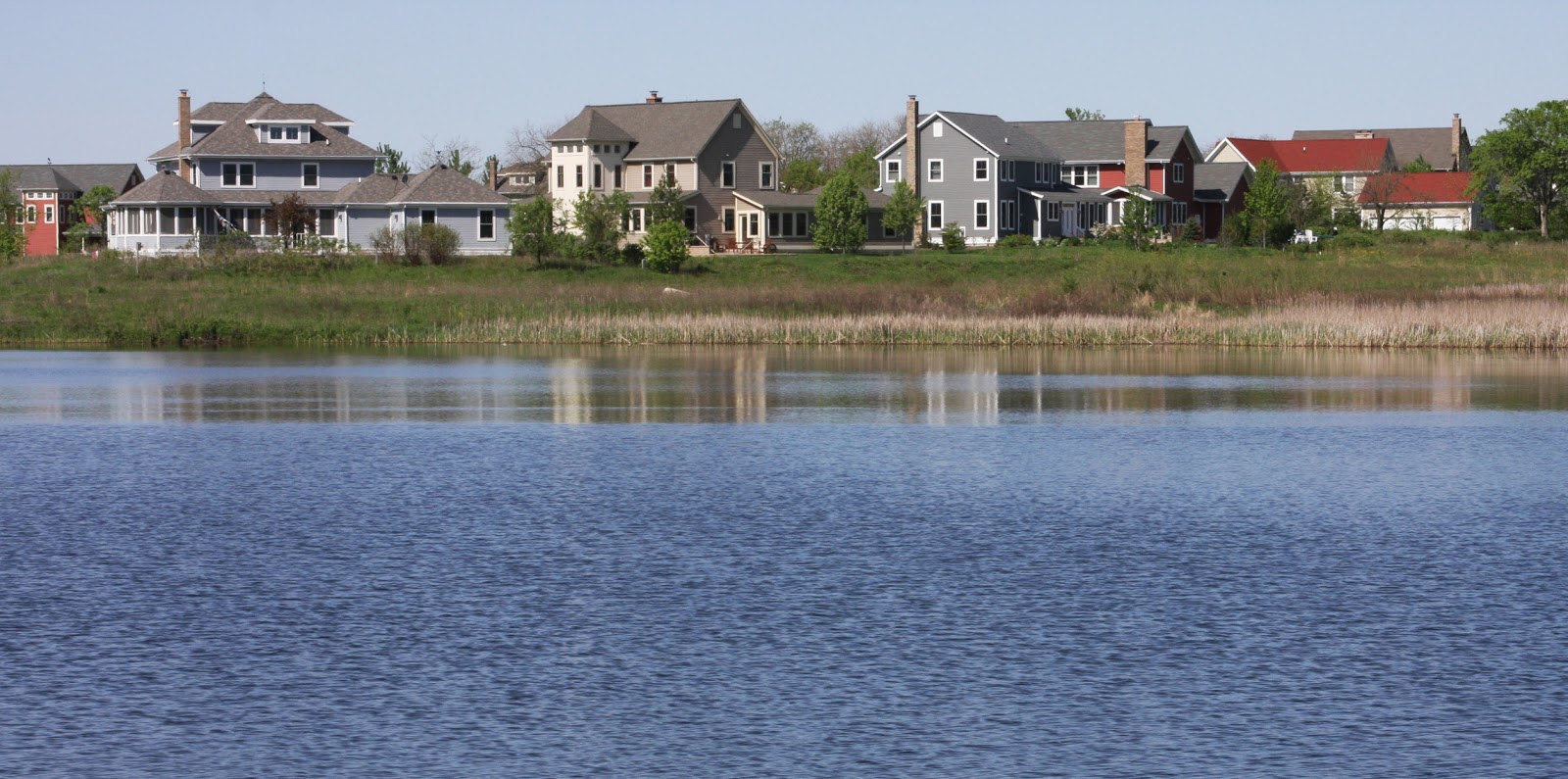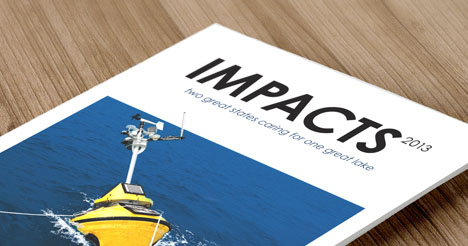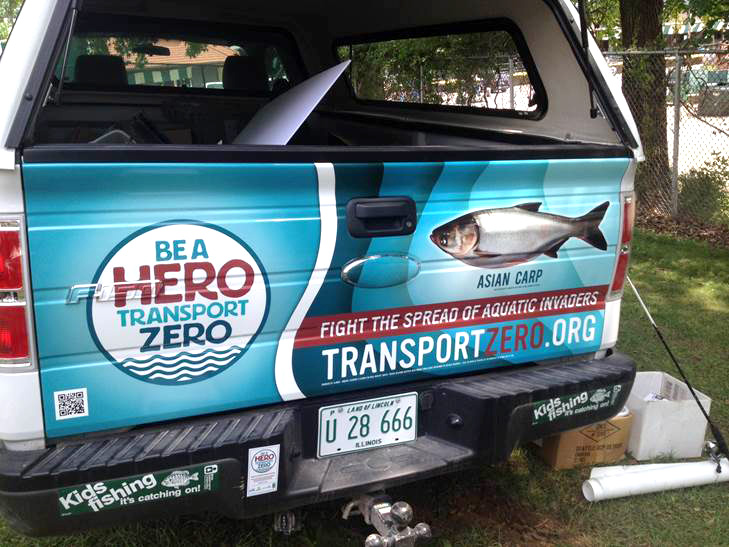April 27th, 2015 by iisg_superadmin
The Wonder Lake Master Property Owners Association is reminding boaters, anglers, and water skiers to remove, drain, and dry after a day on the water to prevent the spread of invasive species. These Be a Hero—Transport Zero™ steps can now be found at 14 boat ramps around the Illinois private lake.
 The signs were installed during the annual spring cleanup, one of many events hosted by the Wonder Lake Sportsman’s Club. And it’s just the latest effort designed to raise awareness of aquatic invasive species and how they spread.
The signs were installed during the annual spring cleanup, one of many events hosted by the Wonder Lake Sportsman’s Club. And it’s just the latest effort designed to raise awareness of aquatic invasive species and how they spread.
The recent surge of outreach at Wonder Lake is largely driven by concern over invasive plants like Phragmites, a species that’s spreading quickly across the Great Lakes region. Plant life along the lakeshore is limited now, but an ongoing dredging project is expected to change that.
Randy Stowe, the lake manager, wants to make sure that the species that move in don’t pose a threat to habitats and recreation.
“We’ll be reaching out to those who own the land along the lake to educate them about invasive plants—how to recognize them, and what to do if you find one,” said Stowe. “We’re really trying to stay ahead of things.”
Learn more about how you can fight the spread of invasive species at TransportZero.org.
***Photo credit: Wonder Lake Sportsman’s Club
March 4th, 2015 by iisg_superadmin
A closer look at web tools and sites that boost research and empower Great Lakes communities to secure a healthy environment and economy.
Even in the gloomy winter months, the beauty of southern Lake Michigan’s natural and urban landscapes is undeniable. But you don’t have to take our word for it. Our photo bank is chock full of stunning images of some of the area’s most celebrated sites—Illinois Beach, downtown Chicago, the Indiana Dunes, and more.
To see the full range of galleries, visit iisg.photoshelter.com or click on ‘Photos’ on our homepage.
If you see one you’d like to include in your own print or online resources, click on ‘Contact’ at the top of the page and send us a request.
February 5th, 2015 by iisg_superadmin
Fisheries managers have long known that the population of rainbow smelt in the Great Lakes is on the decline. Once so abundant that they could be fished out with a pot or strainer, this important prey fish survives today in numbers hovering near historic lows. Numerous causes for the falling population have been proposed, but new research suggests that the population patterns and the forces driving them are more complicated than previously believed.
 The 2014 study reveals that number of smelt that survive their first few months has actually been on the rise since 2000. But this increase in hatchlings isn’t translating into more adults, and it is unclear when and why that breakdown is happening. Whatever the cause, the loss of adult rainbow smelt is enough keep the population trending down even as offspring survival improves.
The 2014 study reveals that number of smelt that survive their first few months has actually been on the rise since 2000. But this increase in hatchlings isn’t translating into more adults, and it is unclear when and why that breakdown is happening. Whatever the cause, the loss of adult rainbow smelt is enough keep the population trending down even as offspring survival improves.
Researchers from USGS, IISG, Purdue University, and the U.S. EPA Great Lakes National Program Office, discovered the unexpected increase in offspring after analyzing roughly 40 years of fisheries data using a novel modeling technique.
Fish populations are typically analyzed using a statistical model that that assumes the relationships between different variables—things like number of offspring, number of adults, degree of predatory pressure, and amount of rainfall—remain the same over time. For this study, researchers used statistical tools rarely used by fishery scientists that better reflect the ever-changing nature of the Great Lakes and make it possible to detect more subtle population patterns.
Perhaps most surprising is that offspring survival is on the rise in Lake Michigan despite the fact that their parents are up to 70 mm shorter now than they were in the 1970s.
“We were expecting to see a decrease in productivity because the adults are maturing at smaller sizes, which should mean fewer eggs and less healthy hatchlings,” said Zach Feiner, a PhD student at Purdue University and lead author of the study. “This raises a lot of questions about how well we understand rainbow smelt fisheries.”
Researchers speculate that the drop in the number of adult smelt may actually be allowing hatchlings to thrive. Adult rainbow smelt frequently supplement their diet of zooplankton by dining on their offspring. Fewer adults means fewer predators for juvenile smelt. The need to find food in a lake infested with millions of quagga and zebra mussels that filter out plankton may also be driving adults further out into the lake and away from spawning grounds.
***Photo courtesy of Crystal Lake Mixing Project.
December 10th, 2014 by iisg_superadmin
A closer look at web tools and sites that boost research and empower Great Lakes communities to secure a healthy environment and economy.
It’s getting a little chilly for a stroll in the Windy City, but don’t let that stop you from enjoying it’s beautiful downtown lakefront. With Chicago Water Walk, you can explore some of the city’s most celebrated sites—Navy Pier, the Chicago River, downtown marinas, Buckingham Fountain, and Museum Campus—from anywhere.
The mobile-friendly website takes viewers on a journey through time to discover how Lake Michigan and the Chicago River transformed a small trading post into one of the economic and cultural hubs of the world—and the vital role these natural resources play in the city’s present and future.
Each stop in the virtual tour combines history, current events, and water sciences with fun facts to show the importance of aquatic ecosystems in the city’s past, present, and future. Stunning photos, historical images, and links to videos and other resources bring these issues to life and reveal a lakefront that will surprise even lifelong Chicagoans.
Visit the website and you’ll learn why the decision to reverse the Chicago River is still making waves more than a century later, how a city that sits along Lake Michigan can be concerned about having enough water in the future, and how native trees and plants are helping the city prepare for changing weather patterns. You’ll also hear about efforts to restore much-needed habitats for millions of birds, fish, and other wildlife.
And for those willing to brave the cold, a mobile tour app is available for free on Apple devices. You can follow the suggested routes or visit the sites that most appeal to you using the app’s interactive map.
The Chicago Water Walk website and app were developed by Illinois-Indiana Sea Grant with funding from the Illinois Department of Natural Resources Coastal Management Program and technical support from the University of Illinois Administrative Information Technology Services.
October 7th, 2014 by iisg_superadmin
Scientists from Central Michigan University’s Institute for Great Lakes Research (IGLR) are expanding their basin-wide Great Lakes coastal wetlands monitoring program with help from grant funding from the U.S. Fish and Wildlife Service and the Wisconsin and Illinois-Indiana Sea Grant programs. The program is one part of a collaborative project that brings together researchers from IGLR, Notre Dame, and the University of Wisconsin-Green Bay. The results will help natural resource managers better target protection and restoration efforts.
From the Midland Daily News:
They also will be able to help assess the importance of coastal wetlands as they relate to the food web of the Great Lakes ecosystem by studying otoliths, or fish ear bones, to determine where fish are obtaining energy for growth.
Otoliths grow daily, similar to rings found in the trunk of a tree. With the use of a precise laser beam, IGLR researchers can sample the chemical composition of targeted areas of the otoliths and relate this “chemical fingerprint” to specific coastal wetlands, even when fish are caught in the open water of the Great Lakes, far from any wetlands.
It is hoped that this research will result in a long-term, sustainable monitoring program aimed at restoring and protecting Great Lakes coastal wetlands, which provide a critical habitat for many species of birds, mammals, reptiles and amphibians, and an essential spawning and nursery habitat for many fish species of ecological and economical importance to Michigan’s $7.5 billion commercial and sports fishing industry.
The research project is one of three awarded a combined total of $380,000 from IISG earlier this year. Additional projects seek to uncover the connections between sediment removal projects and a community’s ability to weather environmental hazards and identify why people adopt stormwater management practices.
And IISG continues to fund strong research projects like these. In fact, last month we announced a new funding opportunity for research addressing key economic planning questions facing the Great Lakes region. Researchers may request up to $96,000 for 18 months. Proposals are due by 5 pm CST on Nov. 17, 2014. Read the full RFP for information on project and application requirements.
September 23rd, 2014 by iisg_superadmin
 Indiana communities along Lake Michigan are celebrating this year’s SepticSmart Week, Sept. 22-26, by reminding homeowners of the importance of septic system maintenance to environmental and public health.
Indiana communities along Lake Michigan are celebrating this year’s SepticSmart Week, Sept. 22-26, by reminding homeowners of the importance of septic system maintenance to environmental and public health.
An estimated 60,000 households in Lake, Porter, and LaPorte counties depend on septic systems to treat wastewater. Without regular maintenance, these systems can backup or overflow, contaminating nearby lakes, rivers, and groundwater supplies with everything from excess nutrients to E. coli to pharmaceutical chemicals. Septic system failures are also one of the primary causes of beach closures in Indiana.
To prevent failures, U.S. EPA and the Northwest Indiana Septic System Coordination Work Group has some advice for homeowners:
-
Protect it and inspect it: Have your system inspected every three years by a licensed contractor and have your tank pumped when necessary, typically every 3-5 years. Many septic system failures occur during the holiday season, so be sure to get your system inspected and serviced now before inspectors’ schedules fill up around the holidays.
-
Think at the sink: Avoid pouring fats, grease and solids down the drain. These substances can clog pipes and the drain field.
-
Don’t overload the commode: Only put things in the drain or toilet that belong there. Coffee grounds, dental floss, diapers and wipes, feminine hygiene products, cigarette butts, and cat litter can clog and damage septic systems.
-
Don’t strain your drain: Be water efficient and spread out water use. Fix plumbing leaks and install faucet aerators and water-efficient products. Spread out laundry and dishwasher loads throughout the day. Too much water at once can overload a system that hasn’t been pumped recently.
-
Shield your field: Remind guests not to park or drive on the drain field, which could damage buried pipes or disrupt underground flow.
The Northwest Indiana Septic System Coordination Work Group brings together federal, state, and local governments and agencies, state and county health departments, and not-for-profits to provide homeowners with information and assistance on the proper care of septic systems. IISG’s Leslie Dorworth has been a part of the group since it began in 2012. For more information or to get involved locally, contact Dorreen Carey at the Indiana DNR Lake Michigan Coastal Program at 219-921-0863 or dcarey@dnr.in.gov.
SepticSmart Week is part of U.S. EPA’s year-round SepticSmart program. In addition to educating property owners, the program is an online resource for industry practitioners, local governments and community organizations that provides access to tools to educate clients and residents.
September 17th, 2014 by iisg_superadmin
 Lawn care decisions play a large role in local water quality and the health of aquatic wildlife. The fertilizers, pesticides, and other chemicals we put on our lawns can be washed into nearby lakes and rivers in stormwater runoff. Once there, these pollutants spur algae growth, clog gills, decrease resistance to disease, and suffocate eggs and newly hatched larvae.
Lawn care decisions play a large role in local water quality and the health of aquatic wildlife. The fertilizers, pesticides, and other chemicals we put on our lawns can be washed into nearby lakes and rivers in stormwater runoff. Once there, these pollutants spur algae growth, clog gills, decrease resistance to disease, and suffocate eggs and newly hatched larvae.
The IISG-led Lawn to Lake program continues to educate homeowners, landscapers, and master gardeners on natural lawn care practices that can improve soil health and protect water quality. The program works with community partners across the region to conduct training workshops and provide ‘how to’ resources for a range of audiences.
Lawn to Lake outreach has led to management changes on an estimated 22,415 lawn acres. These changes are expected to reduce the use of lawn care chemicals, including weed and feed, by more than 3 million pounds a year, protecting nearby aquatic ecosystems from chemical-laden runoff while fostering healthy lawns.
 To learn more about how IISG is empowering communities and individuals to secure a healthy environment, check out our 2013 program impacts.
To learn more about how IISG is empowering communities and individuals to secure a healthy environment, check out our 2013 program impacts.
September 9th, 2014 by iisg_superadmin
 When we first introduced you to Allison Neubauer she was a summer intern working with IISG’s Kristin TePas to develop a website and other outreach materials for the U.S. EPA research vessel Lake Guardian. That was last summer. Today we are happy to announce that Allison is still working hard to improve Great Lakes literacy. Only now she is doing it as a member of our education team.
When we first introduced you to Allison Neubauer she was a summer intern working with IISG’s Kristin TePas to develop a website and other outreach materials for the U.S. EPA research vessel Lake Guardian. That was last summer. Today we are happy to announce that Allison is still working hard to improve Great Lakes literacy. Only now she is doing it as a member of our education team.
As a Sea Grant educator, Allison Neubauer works with Terri Hallesy to plan and facilitate educator workshops and develop classroom resources. She also plays a key role in IISG’s undergraduate service-learning courses at the University of Illinois by leading classroom activities and serving as a resource for students as they implement community projects.
Allison joined the education team as an assistant straight out of her internship. During that time, she helped plan and implement the Great Lakes B-WET project, which received an Outstanding Great Lakes Outreach Programming Award.
She holds two Bachelor’s degrees from the University of Illinois at Urbana-Champaign, one in geography and geographic information sciences and a second in earth, society, and the environment.
August 27th, 2014 by iisg_superadmin
Summer is coming to an end, but there is still plenty of fun to be had this weekend. If you’re like us, you’re anxious to hit the road to your favorite beach, boat launch, or fishing spot. But before you do, we have a message that will help keep these places healthy for many Labor Days to come. And you may just see it on the car in front of you.
The Illinois Department of Natural Resources has emblazoned nine vehicles with a reminder to Be a Hero—Transport Zero. It’s all part of a statewide program that is raising awareness about how the public can help prevent the spread of invasive species on land and in waterways. These plants and animals can wreak havoc on food webs, water quality, and recreation. The three featured in IDNR’s tailgate designs—Asian carp, zebra mussel, and hydrilla—are some of the worst offenders, but there are many more, and they aren’t always easy to recognize.
So what can you do? Just follow three easy steps before you leave the water this weekend:
– Remove any plants, animals, and mud from boats, trailers, and equipment
– Drain everything—bait buckets, live wells, etc.
– Dry everything with a towel
From boaters and kayakers to waterfowl hunters, scuba divers, swimmers, and more, we can all help prevent invasive species from taking over our favorite waterways.
See you on the water!
 The signs were installed during the annual spring cleanup, one of many events hosted by the Wonder Lake Sportsman’s Club. And it’s just the latest effort designed to raise awareness of aquatic invasive species and how they spread.
The signs were installed during the annual spring cleanup, one of many events hosted by the Wonder Lake Sportsman’s Club. And it’s just the latest effort designed to raise awareness of aquatic invasive species and how they spread. 









